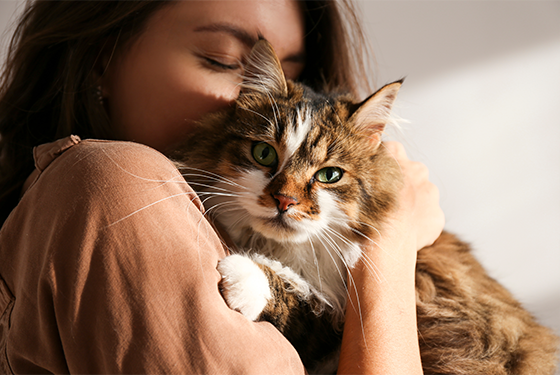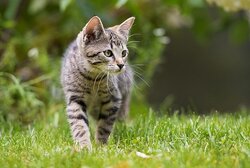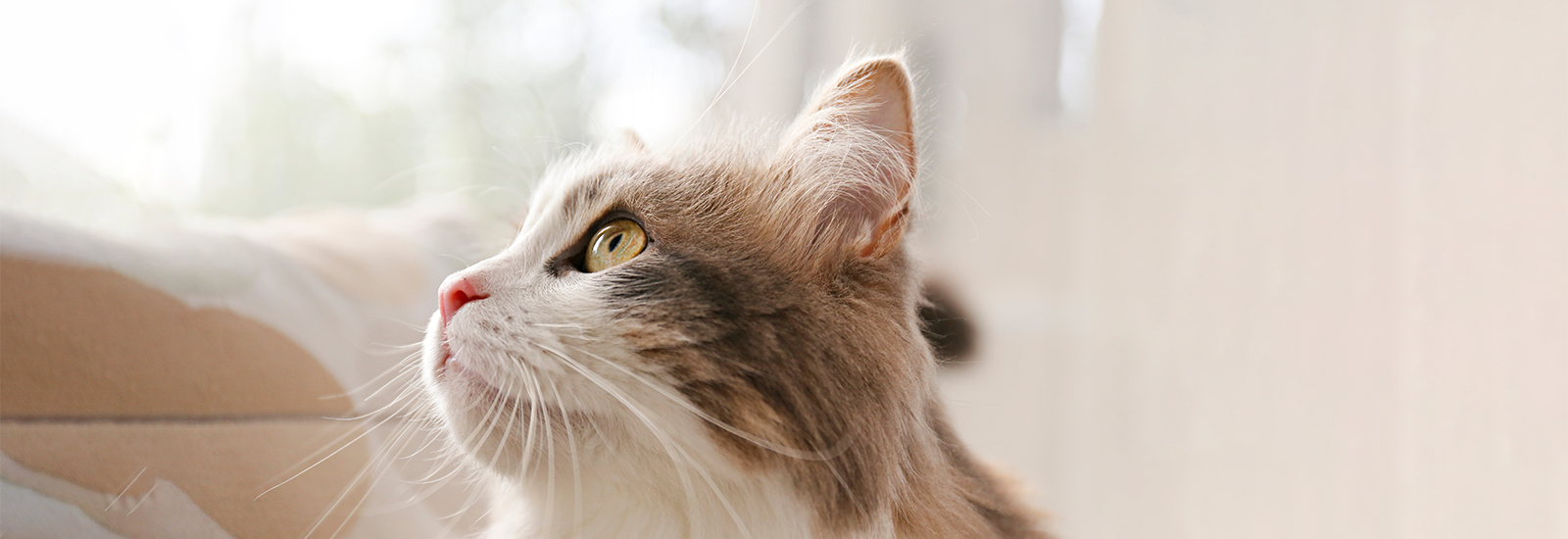Siberian cat
The Siberian cat is a naturally evolved breed of cat from the far north. It is very confident and agile, but can transform into a real snuggler in the blink of an eye.
Profile of the Siberian cat
- Size large
- Weight female: approx. 5 kg, male: approx. 7.5 kg
- Origin Russia
- Build strong, female more petite
- Length of fur medium-long
- Colour of fur all colours (no “points”)
- Grooming medium
- Behaviour agile, confident
- Character clever, people-orientated
Appearance and character of the Siberian cat
A Siberian cat has a very impressive appearance. Although it is slightly smaller than the Norwegian Forest Cat, it can easily compete with it when it comes to its fur. Especially in winter, the Siberian cat develops a very dense, voluminous coat. It then has a stately ruff of fur around its neck, and “knickerbockers”, meaning its particularly fluffy coat on its upper hind legs. The tufts of hair on the ears are also distinctive. Although these are not a requirement of the breed standard, they are highly desirable. They emphasise the natural appearance of the Siberian cat. This is also reflected in the fact that there are no particular colour specifications for the eyes and fur. Almost any colour is allowed. A distinction is, however, made between cats with and without points. A true Siberian cat should not have points, i.e. coloured fur on the ears, the face and the tip of the tail.
Pointed markings are exclusive to the Siberian cat’s sister breed, the Neva Masquerade. The acceptable colour varieties for the points are seal, blue, red, cream, seal/blue tortie, smoke, tabby and/or silver/gold. Most cat associations regard the Neva Masquerade as a breed in its own right, although some only list it as a special colour variant. With the exception of the colouring of their coats, both have exactly the same breed standard. This states that they are a medium to large breed, with the females usually smaller than the males. They have well-proportioned bodies, big heads and large eyes.
With regard to its character, the Siberian cat has both a degree of wildness and an affectionate nature. It is often a lover of the great outdoors that is self-confident, likes hunting, and knows how to defend itself. When it does not like something it makes this clear. This is, however, just one side of its character. The Siberian cat is in no way a loner that will not let people get close to it. It too needs affection, and demands its daily cuddles as and when it feels like it. It really enjoys this contact with its humans, but as is typical for cats, when it has had enough it will get up and look for another spot to snuggle up in.

Keeping and caring for a Siberian cat
Life with a Siberian cat is not at all problematic and it is a perfect family pet. You should not, however, expect it to always be reserved and quiet. It was originally – and still is – a domestic cat from northern Russia. Just like our domestic and farm cats, some of them have a great deal of dormant energy. If they are allowed to go outside, they like to show off their stamina and agility while hunting. However, it is by no means always possible or indeed advisable to let them go outdoors. A cat-proof garden or balcony is a great alternative. Otherwise, they will also be happy if they have enough things to keep them occupied indoors. These should include a cat tree that reaches up to the ceiling, cuddly caves, and a wide variety of toys. It is, however, ideal if your four-legged friend has another cat living with it with whom it can socialise and get up to mischief throughout the day and night. You also have to do your part: the Siberian cat needs plenty of attention every day in order to be happy.
Grooming is not complicated at all, but you should also not underestimate its importance. Large amounts of fur are accumulated, especially during moulting periods. If the cat is allowed outside, it will lose some of its fur there. But even then it is important to regularly use a brush or comb. This makes things easier for the cat when moulting and minimises the risk of it swallowing too much fur when it cleans itself, which could cause problems in the gastrointestinal tract. It also prevents its coat from matting.
Nutrition
Whether it’s a kitten, an adult cat or a senior – the food for a Siberian cat should always be of high quality and tailored to its age. Cats are carnivores by nature, so cat food should always contain a high proportion of meaty ingredients. Sugar, flavour enhancers and artificial colourings and preservatives do not belong in the food.
animonda has the ideal food for every stage of your cat’s life. You can choose between kitten, adult and senior cat food. The products are specially formulated to meet the specific nutritional requirements of the different life stages of cats. This provides the best foundation for your pet to enjoy a long and healthy life.
Health of the Siberian cat
The Siberian cat is a naturally occurring breed that is spared most hereditary diseases to a large extent.
Responsible breeders will therefore have all their cats genetically tested and will exclude any cats with health issues from breeding. For this reason, if you are interested in a Siberian cat, make sure that you find a reputable breeder who is able to document their commitment with health certificates.
Despite preventive healthcare, illnesses can still occur. These include polycystic kidney disease (PKD). Here, cysts form on the cat’s kidneys. Although there is no cure, the condition can be treated and slowed down with the help of medication.
Another hereditary disease that occasionally occurs in Siberian cats is the heart condition HCM (hypertrophic cardiomyopathy). Here, the muscular wall of the heart is thickened, causing the heart chamber to become smaller and able to hold less blood. This leads to accelerated breathing and fatigue. HCM can be diagnosed by means of an ultrasound scan.
History and breeding
The Siberian cat has lived in Russia for centuries, especially in Siberia, which is where it gets its name from. It is the counterpart of our normal domestic and farm cats. Its job has always been to hunt mice. However, as the Siberian temperatures are significantly lower than in the rest of Europe, it has developed an extremely thick coat. So if you have a Siberian cat that is allowed outdoors, do not be surprised if it wants to go outside even in the depths of winter. This breed of cat does not mind the cold at all. After all, it is perfectly protected by its double-layered coat. The undercoat does not lie flat on the body, which gives it a particularly voluminous appearance, making it a real eye-catcher. This is certainly what many visitors thought at the world’s first ever cat show in London in 1871, where the Siberian cat – or more accurately its predecessor – was first introduced to the western world.
The breed arrived in Germany via the former German Democratic Republic. The first examples appeared there in 1985 and the registration and breeding of the Siberian cat began. In 1992 it was recognised by the World Cat Federation and then in 1996 by the European governing body FiFe.
You may also like this

Feeding kittens - nutrition tips
What small kittens need for healthy development

Good cat food
How to recognize good cat food for your darling

Kitten zieht ein
Tips for Collection, initial equipment and settling in

Getting your cat used to being outdoors
This is how you get your cat used to being outdoors

